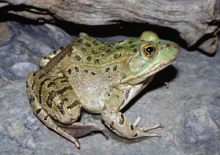Article
An amphibious creature surprisingly populous in the arid west, found in ephemeral waterways and during the summer monsoons. In the Navajo tradition, Frog (or First Frog) is the deity who can make floodwaters recede, spread water over fire, and who plays a role in fertility. The Navajo believe that when the First People came to the present world, Frog volunteered to release the black rain from one of his coats to put out the fire started by Coyote when he stole it from Fire Man. Crane volunteered to fly and carry frog over the fire to accomplish this task.
Also found in some versions of the Navajo tradition, it is taboo to kill a frog, or any other amphibian, due to their strong association with the curative and destructive powers of water. It is believed that to take the life of a frog would result in devastating floods and ruined crops, and the frog killer would require a healing ceremony. Another Navajo taboo associated with frogs is watching a frog eat, which would result in difficulty swallowing and other throat conditions.
"Threatened Chiricahua leopard frog (Rana chiricahuensis), Coconino National Forest, Arizona, November 30, 2009," by Jimmy Rorabaugh, USFWS, is licensed under CC BY-SA.
Manuscripts
References
Bullow, Ernest
N.d. Navajo Taboos for Nature, Domestic, and Wild Animals.
http://www.navajocentral.org/navajotaboos/taboos_nature.html, accessed June 10, 2014.
Leeming, David
2014 Navajo Creation Story. The American Mosaic. http://americanindian2.abc-clio.com/,
accessed June 11, 2014.
Newcomb, Franc Johnson
1967 Navaho Folk Tales. Albuquerque: University of New Mexico Press.

